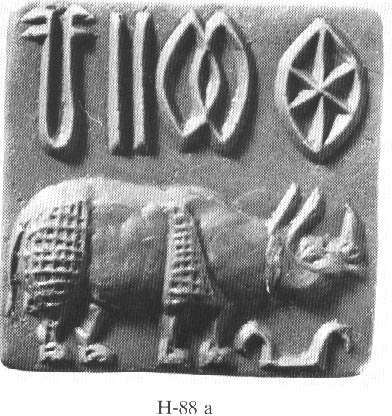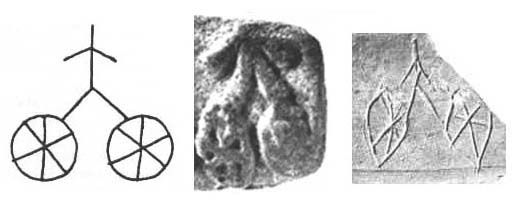Is Sethna’s Chariot Pulled by Rajaram’s Horse?
© S.A. Farmer 2000
Go to lecture and article downloads
Is K. D. Sethna’s famous ‘man on a chariot’ yoked to one of Rajaram’s imaginary Harappan horses? Check out the evidence for yourself!
K. D. Sethna’s The Problem of Aryan Origins, which is much cited by Indian nationalists, talks a lot about Harappan ‘six-spoked wheels.’ S. Kalyanaraman is a believer — and evidently a believer as well in ‘Rajaram Horse II’ (arguably making him the only person in the world besides Rajaram to believe in it).
(If you don’t know about ‘Rajaram Horse II,’ go to Rajaram Horse Articles Download Page, and download the file entitled A Tale of Two Horses, from the recent issue of Frontline, the Indian news magazine. If you don’t know what I’m talking about when I mention ‘Rajaram’s Horse I or II,’ download the other PDF files on that page as well. )
What Sethna doesn’t bother to tell his readers is that the vast majority of Harappan ‘six-spoked wheels’ are ovals, not round — and many others have pointy ends. That would make for one hell of a rough ‘chariot’ ride: If Harappans spent their time making oval or pointed chariot wheels, Harappan jokes could substitute for ‘Polish jokes’ or ‘Little Moron jokes’ or ‘Rajaram horse jokes’ — that is, jokes about archetypal human stupidity. See Figure 1.

Seal Impression H-88 a from Parpola (1987). The vast majority of so-called ‘six-spoked wheel’ images in the Harappan or Indus script, like the one shown here, are not round but oval in shape, and many have pointy ends as well. When you look at the originals, it is evident that they are not flat on the outside either, as any functioning wheel must be. K. N. Sethna doesn’t say a word about these things in his book, which makes a big deal about these ‘wheels.’ Caveat lector!
The argument that the large body of oval or pointy ‘wheels’ are different signs from the few roundish variants doesn’t work, as is suggested by the statistical similarities in contiguous signs.
Sethna also gives us a neat little diagram of a man supposedly riding a chariot, telling us that his diagram ‘should make it perfectly evident that these representations are the wheels of a chariot’ (2nd ed., p. 50).
What is ‘perfectly evident’ to Sethna is dubious at best to anyone who bothers to check out the evidence, with which Sethna plays fast and loose. See Figure 2.

Image on the Left. K. D. Sethna’s sketch of a supposed Harappan ‘chariot,’ which he claims is based on Finnish Concordance seal #3357 (Parpola H-212 A). He offers his diagram to show that it is ‘perfectly evident that these representations [Harappan “wheels” in general] are the wheels of a chariot.’
Image in the Middle. Finnish Concordance seal #3357 from Harappa = Parpola H-212 A — Sethna’s original. The seal is worn, but is obviously clear enough to show that what is found on the seal is not a ‘chariot ‘ with anything approaching round ‘wheels.’
Image on the Right. The only other example of the same sign — in this case graffiti scratched on a piece of pottery (Finnish Concordance number #6290, Parpola L-221, from Lothal). The contiguous signs in both the Harappan and Lothal examples are identical, strongly suggesting that they are the same and not different signs.
If confronted with this evidence, Sethna could potentially argue that the Harappan artists were incompetent and incapable of drawing round wheels. This would let him ‘save his text,’ to use the scholastic phrase for this sort of hermeneutics, but it would be a tough argument to support given the high level of artisanship seen elsewhere on Indus inscriptions. In any event, Sethna doesn’t use this argument, but is satisfied with letting the reader think that the ‘wheels’ are perfectly round — not showing the original evidence, which tells a different story. Hunter’s diagram of the same seal from the 1930s isn’t nearly as regular as Sethna’s.
To put it bluntly: Sethna’s ‘wheels’ aren’t round — as is immediately evident when we look at the originals of his imaginary ‘chariot,’ which he regularizes in his neat little diagram.
I propose that Sethna’s ‘chariot’ exists only in a world where it can be pulled by Rajaram’s Harappan ‘horses.’ No other animal could get the job done.
November 9, 2000
Feb 2023 format changes from web server migration.
